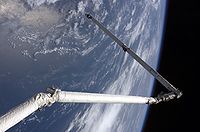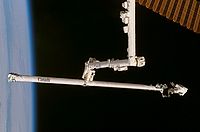
Orbiter Boom Sensor System
Encyclopedia


NASA
The National Aeronautics and Space Administration is the agency of the United States government that is responsible for the nation's civilian space program and for aeronautics and aerospace research...
's Space Shuttle
Space Shuttle
The Space Shuttle was a manned orbital rocket and spacecraft system operated by NASA on 135 missions from 1981 to 2011. The system combined rocket launch, orbital spacecraft, and re-entry spaceplane with modular add-ons...
s. The boom can be grappled by the Canadarm and serves as an extension of the arm, doubling its length to a combined total of 100 feet (30 m). At the far end of the boom is an instrumentation package of cameras and lasers used to scan the leading edges of the wings, the nose cap, and the crew compartment after each lift-off and before each landing. If flight engineers suspect potential damage to other areas, as evidenced in imagery captured during lift-off or the rendezvous pitch maneuver
Rendezvous pitch maneuver
The R-bar pitch maneuver , popularly called the rendezvous pitch maneuver, was a maneuver performed by the space shuttle as it rendezvoused with the International Space Station prior to docking. The shuttle performed a backflip that exposed its heat-shield to the crew of the ISS that made...
, then additional regions may be scanned.
The OBSS was introduced to the shuttle fleet with STS-114
STS-114
-Original crew:This mission was to carry the Expedition 7 crew to the ISS and bring home the Expedition 6 crew. The original crew was to be:-Mission highlights:...
, the "Return to Flight" mission executed by Discovery
Space Shuttle Discovery
Space Shuttle Discovery is one of the retired orbiters of the Space Shuttle program of NASA, the space agency of the United States, and was operational from its maiden flight, STS-41-D on August 30, 1984, until its final landing during STS-133 on March 9, 2011...
, and was flown on every mission since. It is used to inspect the shuttle for damage to the heatshield, officially called Thermal Protection System
Space shuttle thermal protection system
The Space Shuttle thermal protection system is the barrier that protects the Space Shuttle Orbiter during the searing heat of atmospheric reentry...
(TPS), that could jeopardize the shuttle during re-entry. The decision to perform focused inspections of the TPS was prompted by the Space Shuttle Columbia disaster
Space Shuttle Columbia disaster
The Space Shuttle Columbia disaster occurred on February 1, 2003, when shortly before it was scheduled to conclude its 28th mission, STS-107, the Space Shuttle Columbia disintegrated over Texas and Louisiana during re-entry into the Earth's atmosphere, resulting in the death of all seven crew members...
, in which a shuttle was destroyed due to damage inflicted to the heatshield during lift-off. The OBSS is central to focused inspections of the TPS, not only because it carries all the instruments necessary for detailed measurements and observations, but also because without it the Canadarm is too short to reach to all the areas that need to be surveyed.
Description
The boom is essentially the same design as the Canadarm itself, except that the articulatory joints are fixed. OBSS arms for the three remaining orbiters were manufactured relatively quickly, primarily because some spare parts for the Canadarm system were used.Two instrumentation packages are installed at the far end of the OBSS. Sensor package 1 consists of the Laser Dynamic Range Imager
Laser Dynamic Range Imager
The Laser Dynamic Range Imager is a LADAR device developed by Sandia National Laboratories for the US Space Shuttle program. The sensor was developed as part of NASA's Return to Flight effort following the Space Shuttle Columbia disaster to provide 2-D and 3-D images of the Thermal Protection...
(LDRI) and an Intensified Television Camera (ITVC). Sensor package 2 is the Laser Camera System
Laser Camera System
Neptec Design Group's Laser Camera System is short-range, high precision autosynchronous triangulation scanner —– or more simply, a very sensitive, highly accurate 3D scanner...
(LCS) and a digital camera (IDC). The sensors can record at a resolution of a few millimeters, and can scan at a rate of about 2.5 inches (6.4 cm) per second.
It is also fitted with handrails, so that the boom could be used to provide spacewalkers with access to the shuttle's underbelly in case in-flight repairs are required.
STS-120 ISS repair
During STS-120STS-120
-Crew notes:As commander of STS-120, Pamela Melroy became the second woman to command a space shuttle mission. Additionally, the Expedition 16 crew that received STS-120 was commanded by Peggy Whitson, the first female ISS commander...
the OBSS was used as an extension boom for the space station's Canadarm2, something it was never designed to do. During this mission the P6 solar array had become damaged during the redeploy. Canadarm2 grabbed the arm on its center grapple fixture
Power Data Grapple Fixture
A Power Data Grapple Fixture is a connection fixture used on the International Space Station . PDGFs can be "grappled" by the Canadarm2 robotic arm, in order to allow Canadarm2 to manipulate a grappled object, or be controlled by operators based inside the ISS.The Canadarm2 is self-relocatable and...
and then astronaut Scott E. Parazynski
Scott E. Parazynski
Scott Edward Parazynski, M.D. is an American physician and a former NASA astronaut. A veteran of five Space Shuttle flights and seven spacewalks, Parazynski's latest mission was STS-120 in October, 2007 --- highlighted by a dramatic, unplanned EVA to repair a live solar array...
was mounted at the end of the boom to make the repair. Because Canadarm2 is unable to power the OBSS it was without power many hours more than it was designed to handle, but because it was heated up considerably before the start of the repair it stayed undamaged.
Enhanced ISS Boom Assembly
Due to the benefits for spacewalkers from the extended range provided by connecting an OBSS to the International Space StationInternational Space Station
The International Space Station is a habitable, artificial satellite in low Earth orbit. The ISS follows the Salyut, Almaz, Cosmos, Skylab, and Mir space stations, as the 11th space station launched, not including the Genesis I and II prototypes...
(ISS)'s robotic arm, NASA implemented a plan for the STS-134
STS-134
STS-134 was the penultimate mission of NASA's Space Shuttle program. The mission marked the 25th and final flight of . This flight delivered the Alpha Magnetic Spectrometer and an ExPRESS Logistics Carrier to the International Space Station. Mark Kelly served as the mission commander...
Space Shuttle mission to leave its OBSS behind on the ISS, where it will permanently remain. The plan resulted in a number of modifications to the OBSS, now known as the Enhanced ISS Boom Assembly, including the addition of a Power Data and Grapple Fixture which enables mating to the robotic arm on the end of the boom with a Canadarm2-compatible grapple fixture to favor station use. The boom was stowed on the ISS S1 Integrated Truss Structure
Integrated Truss Structure
the Integrated Truss Structure forms the backbone of the International Space Station, with mountings for unpressurized logistics carriers, radiators, solar arrays, and other equipment.-History:...
on the fourth spacewalk of STS-134 on May 27, 2011. The OBSS sensors were disconnected during the EVA, and are not designed to withstand thermal conditions outside the ISS without power to keep them warm. However, the modification of the grapple fixture could enable such equipment to be mounted onto the OBSS in the future.

